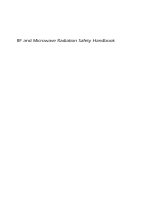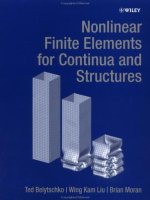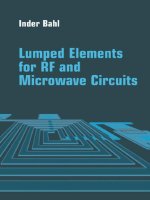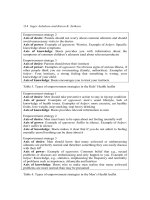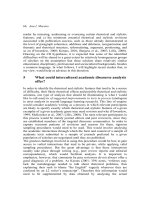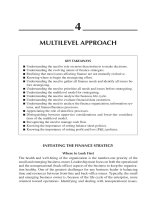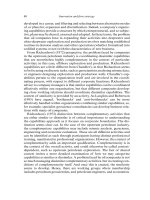Lumped Elements for RF and Microwave Circuits phần 4 ppsx
Bạn đang xem bản rút gọn của tài liệu. Xem và tải ngay bản đầy đủ của tài liệu tại đây (965.41 KB, 55 trang )
133
Printed Inductors
[55] Chang, J. H., et al., ‘‘Effects of Dummy Patterns and Substrate on Spiral Inductors for
Sub-Micron RFICs,’’ IEEE MTT-S Int. Microwave Symp. Dig., 2002, pp. 529–532.
[56] Feng, H., et al., ‘‘Super Compact RFIC Inductors in 0.18
m CMOS with Copper
Interconnects,’’ IEEE MTT-S Int. Microwave Symp. Dig., 2002, pp. 553–556.
[57] Bunch, R. L., D. I. Sanderson, and S. Raman, ‘‘Quality Factor and Inductance in Differen-
tial IC Implementations,’’ IEEE Microwave Magazine, Vol. 3, June 2002, pp. 82–92.
[58] Lin, Y. S., and H. M. Hsu, ‘‘Study of Spiral Inductors Using Cu/Low-k Interconnect for
High Performance Radio-Frequency Integrated Circuit (RF-IC) Applications,’’ Microwave
Optical Tech. Lett., Vol. 34, July 2002, pp. 43–48.
[59] Yaojiang, Z., et al., ‘‘An Accurate Lumped Model for Micromachined Microwave Planar
Spiral Inductors,’’ Int. J. RF and Microwave Computer-Aided Engineering, Vol. 13, 2003.
[60] Burghartz, J. N., and B. Rejaei, ‘‘On the Design of RF Spiral Inductors on Silicon,’’ IEEE
Trans. Electron Devices, 2003, in press.
[61] Sun, Y., et al., ‘‘Suspended Membrane Inductors and Capacitors for Application in Silicon
MMICs,’’ IEEE Microwave and Millimeter-Wave Monolithic Circuits Symp. Dig., 1996,
pp. 99–102.
[62] Jiang, H., et al., ‘‘On-Chip Spiral Inductors Suspended Over Deep Copper-Lined Cavities,’’
IEEE Trans. Microwave Theory Tech., Vol. 48, December 2000, pp. 2415–2423.
[63] Lakdawala, H., et al., ‘‘Micromachined High-Q-Inductors in a 0.18-
m Copper Intercon-
nect Low-K Dielectric CMOS Process,’’ IEEE J. Solid-State Circuits, Vol. 37, March 2002,
pp. 394–403.
[64] Camp, Jr., W. O., S. Tiwari, and D. Parson, ‘‘2-6 GHz Monolithic Microwave Amplifier,’’
IEEE MTT-S Int. Microwave Symp. Dig., 1983, pp. 46–49.
[65] Cahana, D., ‘‘A New Transmission Line Approach for Designing Spiral Microstrip Induc-
tors for Microwave Integrated Circuits,’’ IEEE MTT-S Int. Microwave Symp. Dig., 1983,
pp. 245–247.
[66] Wolff, I., and G. Kibuuka, ‘‘Computer Models for MMIC Capacitors and Inductors,’’
14th European Microwave Conference Proc., 1984, pp. 853–858.
[67] Shepherd, P. R., ‘‘Analysis of Square-Spiral Inductors for Use in MMICs,’’ IEEE Trans.
Microwave Theory Tech., Vol. MTT-34, April 1986, pp. 467–472.
[68] Krafcsik, D. M., and D. E. Dawson, ‘‘A Closed-Form Expression for Representing the
Distributed Nature of the Spiral Inductor,’’ IEEE MTT-S Int. Microwave Symp. Dig.,
1986, pp. 87–92.
[69] Pettenpaul, E., et al., ‘‘CAD Models of Lumped Elements on GaAs up to 18 GHz,’’ IEEE
Trans. Microwave Theory Tech., Vol. 36, February 1988, pp. 294–304.
[70] Geen, M. W., et al., ‘‘Miniature Mutilayer Spiral Inductors for GaAs MMICs,’’ IEEE
GaAs IC Symp. Dig., 1989, pp. 303–306.
[71] Shih, Y. C., C. K. Pao, and T. Itoh, ‘‘A Broadband Parameter Extraction Technique for
the Equivalent Circuit of Planar Inductors,’’ IEEE MTT-S Int. Microwave Symp. Dig.,
1992, pp. 1345–1348.
134 Lumped Elements for RF and Microwave Circuits
[72] Schmuckle, F. J., ‘‘The Method of Lines for the Analysis of Rectangular Spiral Inductors,’’
IEEE Trans. Microwave Theory Tech., Vol. 41, June/July 1993, pp. 1183–1186.
[73] Sadhir, V. K., I. J. Bahl, and D. A. Willems, ‘‘CAD Compatible Accurate Models of
Microwave Passive Lumped Elements for MMIC Applications,’’ Int. J. Microwave and
Millimeter-Wave Computer-Aided Engineering, Vol. 4, April 1994, pp. 148–162.
[74] Engels, M., and R.H. Jansen, ‘‘Modeling and Design of Novel Passive MMIC Components
with Three and More Conductor Levels,’’ IEEE MTT-S Int. Microwave Symp. Dig., 1994,
pp. 1293–1296.
[75] Fisher, D., and I. Bahl, Gallium Arsenide IC Applications Handbook, Boston: Academic
Press, 1995.
[76] Chaki, S., et al., ‘‘Experimental Study of Spiral Inductors,’’ IEEE MTT-S Int. Microwave
Symp. Dig., 1995, pp. 753–756.
[77] Paek, S. W., and K. S. Seo, ‘‘Air-Gap Stacked Spiral Inductor,’’ IEEE Microwave and
Guided Wave Lett., Vol. 7, October 1997, pp. 329–331.
[78] Chuang, J., et al., ‘‘Low Loss Air-Gap Spiral Inductors for MMICs Using Glass Microbump
Bonding Technique,’’ IEEE MTT-S Int. Microwave Symp. Dig., 1998, pp. 131–134.
[79] Bahl, I. J., ‘‘Improved Quality Factor Spiral Inductors on GaAs Substrates,’’ IEEE Micro-
wave and Guided Wave Lett., Vol. 9, October 1999, pp. 398–400.
[80] Bahl, I. J., ‘‘High Current Capacity Multilayer Inductors for RF and Microwave Circuits,’’
Int. J. RF and Microwave Computer-Aided Engineering, Vol. 10, March 2000, pp. 139–146.
[81] Bahl, I. J., ‘‘High Performance Inductors,’’ IEEE Trans. Microwave Theory Tech., Vol. 49,
April 2001, pp. 654–664.
[82] Piernas, B., et al., ‘‘High Q-Factor Three-Dimensional Inductors,’’ IEEE Trans. Microwave
Theory Tech., Vol. 50, August 2002, pp. 1942–1949.
[83] Bahl, I. J., et al., ‘‘Low Loss Multilayer Microstrip Line for Monolithic Microwave Inte-
grated Circuits Applications,’’ Int. J. RF and Microwave Computer-Aided Engineering,
Vol. 8, November 1998, pp. 441–454.
[84] Bahl, I. J., ‘‘High-Q-and Low-Loss Matching Network Elements for RF and Microwave
Circuits,’’ IEEE Microwave Magazine, Vol. 1, September 2000, pp. 64–73.
[85] Lee, S. H., et al., ‘‘High Performance Spiral Inductors Embedded on Organic Substrates
for SOP Applications,’’ IEEE MTT-S Int. Microwave Symp. Dig., 2002, pp. 2229–2232.
[86] Wu, H., and C. Tzuang, ‘‘PBG-Enhanced Inductor,’’ IEEE MTT-S Int. Microwave Symp.
Dig., 2002, pp. 1087–1090.
[87] Acuna, J. E., J. L. Rodriguez, and F. Obelleiro, ‘‘Design of Meander Line Inductors on
Printed Circuit Boards,’’ Int. J. RF and Microwave Computer-Aided Engineering, Vol. 11,
July 2001, pp. 219–230.
[88] Daly, D. A., ‘‘Lumped Elements in MicrowaveIntegrated Circuits,’’ IEEE Trans. Microwave
Theory Tech., Vol. MTT-15, December 1967, pp. 713–721.
[89] Caulton, M., et al., ‘‘Status of Lumped Elements in Microwave Integrated Circuits—
Present and Future,’’ IEEE Trans. Microwave Theory Tech., Vol. MTT-19, July 1971,
pp. 588–599.
135
Printed Inductors
[90] Pieters, P., et al., ‘‘Accurate Modeling of High-Q-Spiral Inductors in Thin-Film Multilayer
Technology for Wireless Telecommunication Applications,’’ IEEE Trans. Microwave Theory
Tech., Vol. 49, April 2001, pp. 589–599.
[91] Park, J. Y., and M. G. Allen, ‘‘ Packaging-Compatible High Q-Microinductors and
Microfilters for Wireless Applications,’’ IEEE Trans. Advanced Packaging, Vol. 22, May
1999, pp. 207–213.
[92] Dayal, H., and Q. Le, ‘‘Printed Inductors on Alumina Substrates,’’ IEEE Microwave
Magazine, Vol. 2, June 2001, pp. 78–86.
[93] Sutono, A., et al., ‘‘Development of Three Dimensional Ceramic-Based MCM Inductors
for Hybrid RF/Microwave Applications,’’ IEEE RF Integrated Circuit Symp. Dig., 1999,
pp. 175–178.
[94] Sutono, A., et al., ‘‘RF/Microwave Characterization of Multilayer Ceramic-Based MCM
Technology,’’ IEEE Trans. Advanced Packaging, Vol. 22, August 1999, pp. 326–336.
[95] Lahti, M., V. Lantto, and S. Leppavuori, ‘‘Planar Inductors on an LTCC Substrate Realized
by the Gravure-Offset-Printing Technique,’’ IEEE Trans. Components Packaging Tech.,
Vol. 23, December 2000, pp. 606–615.
[96] Sutono, A., et al., ‘‘High Q-LTCC-Based Passive Library for Wireless System-on-Package
(SOP) Module Development,’’ IEEE Trans. Microwave Theory Tech., October 2001,
pp. 1715–1724.
[97] Lim, K., et al., ‘‘RF-System-On-Package (SOP) for Wireless Communications,’’ IEEE
Microwave Magazine, Vol. 3, March 2002, pp. 88–99.
[98] Yamaguchi, M., M. Baba, and K. Arai, ‘‘Sandwich-Type Ferromagnetic RF Integrated
Inductor,’’ IEEE Trans. Microwave Theory Tech., Vol. 49, December 2001, pp. 2331–2335.
[99] Yamaguchi, M., T. Kuribara, and K. Arai, ‘‘Two-Port Type Ferromagnetic RF Integrated
Inductor,’’ IEEE MTT-S Int. Microwave Symp. Dig., 2002, pp. 197–200.
4
Wire Inductors
Wire-wound inductors have traditionally been used in biasing chokes and
lumped-element filters at radio frequencies, whereas bond wire inductance is an
integral part of matching networks and component interconnection at microwave
frequencies [1–10]. This chapter provides design information and covers practical
aspects of these inductors.
4.1 Wire-Wound Inductors
Wire-wound inductors can be realized in several forms of coil including rectangu-
lar, circular, solenoid, and toroid. The inductance of a coil can be increased by
wrapping it around a magnetic material core such as a ferrite rod. Figure 4.1
shows various types of wire-wound inductors currently used in RF and microwave
circuits. The basic theory of such inductors is described next.
4.1.1 Analytical Expressions
In this section we describe analytical expressions used for the design of several
types of wire-wound inductors.
4.1.1.1 Circular Coil
The inductance of a single-turn coil shown in Figure 4.2(a) is given by [7]
L =
(2r − a)
ͫͩ
1 −
k
2
2
ͪ
K (k) − E(k)
ͬ
(4.1)
137
138 Lumped Elements for RF and Microwave Circuits
Figure 4.1 Wire-wound inductor configurations.
Figure 4.2 (a) Single turn circular and (b) multiturn coil having large radius-to-length ratio.
139
Wire Inductors
k
2
=
4r(r − a)
(2r − a)
2
(4.2)
where r is the mean radius of the coil and 2a is the diameter of the wire,
is
the permeability of the medium, and E(k) and K (k) are complete elliptic
integrals of the first and second kinds, respectively and are given by
E(k) =
͵
/2
0
√
1 − k
2
sin
2
d
(4.3a)
K (k) =
͵
/2
0
d
√
1 − k
2
sin
2
(4.3b)
When r >> a, k ≅ 1 and the expressions for K (k), E(k), and L become
K (k) ≅ ln
ͩ
4
√
1 − k
2
ͪ
(4.4a)
E(k) ≅ 1 (4.4b)
L ≅ r
ͫ
ln
ͩ
8r
a
ͪ
− 2
ͬ
H (4.5)
Next let us consider a circular coil of closely wound n turns, with cross-
sectional radius a and mean loop radius R as shown in Figure 4.2(b). An
approximate expression for this case is obtained by multiplying (4.5) by a factor
of n
2
and replacing r with R, that is,
L = n
2
R
ͫ
ln
ͩ
8R
a
ͪ
− 2
ͬ
H (4.6)
Here the n
2
factor occurs due to n times current and n integrations to
calculate the voltage induced about the coil. When the medium is air,
=
0
= 4
× 10
−
9
H/cm, and
L = 4
n
2
R
ͫ
ln
ͩ
8R
a
ͪ
− 2
ͬ
(nH) (4.7)
where a and R are in centimeters.
140 Lumped Elements for RF and Microwave Circuits
4.1.1.2 Solenoid Coil
Consider a solenoid coil as shown in Figure 4.3 having number of turns n,
mean radius of R, and length ᐉ. As a first-order approximation we may consider
ᐉ much larger than the radius R and uniform field inside the coil. In this case
the flux density can be written
B
z
=
H
z
=
nI
ᐉ
(4.8)
The total flux linkages for n turns is given by
= n × cross-section area × flux density (4.9)
= n
R
2
n (I/ᐉ )
The inductance of the solenoid becomes
L =
I
=
R
2
n
2
/ᐉ (4.10)
or
L = 4
r
(
Rn)
2
/ᐉ (nH)
where dimensions are in centimeters and
r
is the relative permeability of
the solenoid coil. For coils with the length comparable to the radius, several
Figure 4.3 Solenoid coil configurations: (a) air core and (b) ferrite core.
141
Wire Inductors
semiempirical expressions are available. For ᐉ > 0.8R, an approximate expression,
commonly used is
L =
4
r
(
Rn)
2
ᐉ + 0.9R
(nH) (4.11)
More accurate expressions for an air core material are given in the literature
[8, 10] and reproduced here. For 2R ≤ ᐉ (long coil):
L =
0
n
2
R
2
ᐉ
ͫ
f
1
ͩ
4R
2
ᐉ
2
ͪ
−
8R
3
ᐉ
ͬ
(4.12a)
and for 2R > ᐉ (short coil):
L =
0
n
2
R
ͭͫ
ln
ͩ
8R
ᐉ
ͪ
− 0.5
ͬ
f
1
ͩ
ᐉ
2
4R
2
ͪ
+ f
2
ͩ
ᐉ
2
4R
2
ͪͮ
(4.12b)
where for 0 ≤ x ≤ 1.0
f
1
(x) =
1.0 + 0.383901x + 0.017108x
2
1.0 + 0.258952x
(4.13a)
f
2
(x) = 0.093842x + 0.002029x
2
− 0.000801x
3
(4.13b)
4.1.1.3 Rectangular Solenoid Coil
Ceramic wire-wound inductors as shown in Figure 4.4 are used at high RF
frequencies. These ceramic blocks are of rectangular shape and have connection
Figure 4.4 Ceramic block wire-wound inductor configuration.
142 Lumped Elements for RF and Microwave Circuits
pads. The inductance of these coils can be approximately calculated using (4.11)
or (4.12), when
R =
W + h + a
(4.14)
where W and h are the width and height of the ceramic block, respectively,
and a is the radius of the wire.
As shown in (4.11) as a first-order approximation (W, h >> a), the
inductance of a solenoid does not depend on the diameter of the wire used.
Thus, the selection of wire diameter is dictated by the size of the coil, the
highest frequency of operation, and the current-handling capability. For match-
ing networks and passive components, the smallest size inductors with the
highest possible SRF and Q-values are used.
4.1.1.4 Toroid Coil
If a coil is wound on a donut-shaped or toroidal core, shown in Figure 4.5(a),
the approximate inductance is given as
L =
o
r
a
2
n
2
/ᐉ (4.15)
where ᐉ = 2
R. Here a is the radius of the circular cross-section toroid, R is
the radius of the toroid core, and R >> a. When R and a are comparable, an
approximate expression for inductance is given by [8] as
L = 12.57n
2
R −
√
R
2
− a
2
(nH) (4.16)
where R and a are in centimeters.
An approximate expression for the rectangular cross-section toroid, shown
in Figure 4.5(b), can be derived as follows [6]. The magnetic field due to the
net current flowing through the core is given by
H
=
nI
2
R
1
< r < R
2
(4.17)
The flux through any single loop is
=
o
r
D
͵
R
2
R
1
H
dr =
o
r
DnI
2
ln
ͩ
R
2
R
1
ͪ
(4.18)
143
Wire Inductors
Figure 4.5 Toroid core inductors: (a) circular radius and (b) rectangular radius.
where D is the height of the core and R
1
and R
2
are the inner and outer radii
of the core. The inductance due to n turns is given by
L =
n
I
= 2
r
Dn
2
ln
ͩ
R
2
R
1
ͪ
(nH) (4.19)
where D, R
1
, and R
2
are in centimeters.
When the coil is tightly wound so that there is no gap between the
enameled wire turns, it provides the maximum inductance and the minimum
resonant frequency. Its inductance decreases as the coil is stretched along its
axis. In this case, the interwinding capacitance decreases and increases the
resonant frequency. The inductance of the coil can also be decreased or increased
by inserting, respectively, a conductive (copper) or a magnetic (ferrite) material
144 Lumped Elements for RF and Microwave Circuits
rod inside the core of the winding. Thus, coil stretching or rod insertion in
the core allows the inductance of the coil to vary making it a tunable component.
4.1.2 Compact High-Frequency Inductors
Chip inductors are widely used in RF circuits to realize passive components
and matching networks and as RF chokes for bringing the bias to solid-state
devices. Requirements for applications in passive and matching circuits are a
high Q, high SRF, and low parasitic capacitance, whereas RF chokes need
higher current-handling capability and lower dc resistance values. Also, low-
cost RF front-ends need low profiles or compact size and inexpensive compo-
nents. These inductors are commonly realized by winding an insulating wire
around a ceramic block. Both regular Al
2
O
3
ceramic and high-permeability
ferrite materials are used.
Miniature chip coil inductors having inductance values from 1 to 4,700
nH with SRF ranging from 90 MHz to 6 GHz are commercially available [2].
The Q-values at 250 MHz for 3.6- and 39-nH inductors are 22 and 40,
respectively. Table 4.1 provides the summary of ceramic wire-wound RF inductor
parameters. In the table L Freq, Q Freq, and SRF Min represent the measurement
frequency of inductance, the measurement frequency of Q-factor, and the
minimum value of self-resonant frequency, respectively.
4.1.2.1 High-SRF Inductors
Chip inductors with high SRF are required for applications such as matching
networks and passive components. Chip inductors with inductance values
Table 4.1
Summary of Ceramic Wire-Wound RF Inductor Parameters
Current
dc Rating dc
L Freq Q Freq SRF Min Resistance Max
L (nH) (MHz) Q Min (MHz) (MHz) (Ohm) (mA)
1.0 250 16 250 6,000 0.045 1,360
2.2 250 19 250 6,000 0.070 960
3.9 250 22 250 5,900 0.080 1,000
6.8 250 27 250 5,700 0.110 1,000
12.0 250 35 250 4,000 0.130 986
22.0 250 55 500 2,600 0.220 758
39.0 250 60 500 2,000 0.290 660
100.0 150 65 500 1,200 0.460 524
470.0 25 45 100 450 1.19 449
1,000.0 25 35 50 290 1.75 370
4,700.0 7.9 20 25 90 4.90 221
145
Wire Inductors
up to 15 nH and a SRF greater than 4 GHz are commercially available. The
L и SRF product for smaller value inductors is as large as 24 nH-GHz, whereas
for large value inductors (<100 nH) this product is as large as 120 nH-GHz.
For example, a 100-nH inductor’s SRF is about 1.2 GHz.
4.1.2.2 High-Q Inductors
High-Q chip inductors are required for low-loss matching network, filter, and
resonator applications. For chip inductors, a maximum Q-value of 100 can be
obtained. Figure 4.6 shows the variation of Q for several inductor values.
4.1.2.3 High Current Capability Inductors
Bias chokes used in power amplifiers require high current capabilities. The
current rating given in Table 4.1 for high inductance values (L ≅ 40 nH,
adequate at 1-GHz applications) is about 660 mA. However, other chip inductors
with a current rating of 1.3A are also available [1].
The material properties of gold, aluminum, and copper wires are compared
in Table 4.2. Because copper has a higher melting temperature, lower resistivity
value, and the best thermal conductivity, the material is exclusively used for
low-loss and high current carrying capacity wires. Table 4.3 lists copper wire
parameters for various AWG gauge values.
Figure 4.6 Typical variation of Q as a function of frequency for several chip inductors [1].
146 Lumped Elements for RF and Microwave Circuits
Table 4.2
Material Properties of Wires
Material Property Units Gold Aluminum Copper
Melting temperature, T
m
°C 1063 660 1093
Heat of fusion W-s/g 64 400 202
Thermal conductivity, k W/m-°C 297 240 393
Density G/cm
3
19.3 2.7 8.96
Specific heat W-s/g-°C 0.31 0.886 0.92
Electrical resistivity ⍀.cm 2.4 × 10
−
6
2.6 × 10
−
6
1.7 × 10
−
6
Thermal expansion
coefficient ppm/°C 14.2 23 17
Table 4.3
Copper Wire Parameters at 20°C
AWG Bare Diameter Enamel Coated Resistance Maximum
Gauge (mm, mil) Diameter (mm, mil) (⍀/m) Current (A)
32 0.203, 8.0 0.224, 8.8 0.5385 0.53
30 0.254, 10.0 0.274, 10.8 0.3385 0.86
28 0.320, 12.6 0.343, 13.5 0.2129 1.40
26 0.404, 15.9 0.429, 16.9 0.1339 2.20
24 0.511, 20.1 0.541, 21.3 0.0878 3.50
22 0.643, 25.3 0.676, 26.6 0.0610 7.0
20 0.813, 32.0 0.848, 33.4 0.0343 11.0
18 1.024, 40.3 1.062, 41.8 0.0220 16.0
16 1.290, 50.8 1.331, 52.4 0.0152 22.0
14 1.628, 64.1 1.674, 65.9 0.0086 32.0
12 2.052, 80.8 2.101, 82.7 0.0055 41.0
10 2.588, 101.9 2.639, 103.9 0.0035 55.0
The current-handling values given in Table 4.3 are for straight wires in
air. The current handling capacity of inductors depends on several factors
including the type of winding (tight or loose), the number of turns, and the core
material used. Closely spaced windings tend to modify the current distribution in
the wire cross section, making it more uneven and thus reducing the current
handling ability.
4.2 Bond Wire Inductor
Most RF and microwave circuits and subsystems use bond wires to interconnect
components such as lumped elements, planar transmission lines, solid-state
147
Wire Inductors
devices, and ICs. These bond wires have 0.5- to 1.0-mil diameters and their
lengths are electrically short compared to the operating wavelength. Bond wires
are accurately characterized using simple formulas in terms of their inductances
and series resistances. As a first-order approximation, the parasitic capacitance
associated with bond wires can be neglected.
Commonly used bond wires are made of gold and aluminum. Table 4.2
compares the important properties of these two materials with copper used for
wire-wound inductors.
4.2.1 Single and Multiple Wires
In hybrid MICs, bond wire connections are used to connect active and passive
circuit components, and in MMICs bond wire connections are used to connect
the MMIC chip to other circuitry. The free-space inductance L (in nanohenries)
of a wire of diameter d and length ᐉ (in microns) is given by [11–13]
L = 2 × 10
−
4
ᐉ
ͫ
ln
ͭ
2ᐉ
d
+
√
1 +
ͩ
2ᐉ
d
ͪ
2
ͮ
+
d
2ᐉ
−
√
1 +
ͩ
d
2ᐉ
ͪ
2
+ C
ͬ
(4.20)
where the frequency-dependent correction factor C is a function of bond wire
diameter and its material’s skin depth
␦
expressed as
C = 0.25 tanh (4
␦
/d ) (4.21a)
␦
=
1
√
f
0
(4.21b)
where
is the conductivity of the wire material. For gold wires,
␦
= 2.486f
−
0.5
,
where frequency f is expressed in gigahertz. When
␦
/d is small, C =
␦
/d. When
ᐉ >> d, (4.20) reduces to
L = 2 × 10
−
4
ᐉ
ͩ
ln
4ᐉ
d
+ 0.5
d
ᐉ
− 1 + C
ͪ
(4.22)
The wire resistance R (in ohms) is given by
R =
R
s
ᐉ
d
(4.23a)
148 Lumped Elements for RF and Microwave Circuits
where R
s
is the sheet resistance in ohms per square. Taking into account the
effect of skin depth, (4.23a) can be written
R =
4ᐉ
d
2
ͫ
0.25
d
␦
+ 0.2654
ͬ
(4.23b)
4.2.1.1 Ground Plane Effect
The effect of the ground plane on the inductance value of a wire has also been
considered [11, 14]. If the wire is at a distance h above the ground plane [Figure
4.7(a)], it sees its image at 2h from it. The wire and its image result in a mutual
inductance L
mg
. Because the image wire carries a current opposite to the current
flow in the bond wire, the effective inductance of the bond wire becomes
L
e
= L − L
mg
(4.24a)
where
L
mg
= 2 × 10
−
4
ᐉ
ͫ
ln
ͭ
ᐉ
2h
+
√
1 +
ͩ
ᐉ
2h
ͪ
2
ͮ
+
√
1 +
ͩ
ᐉ
2h
ͪ
2
+
2h
ᐉ
−
√
1 +
ͩ
2h
ᐉ
ͪ
2
+ C
ͬ
(4.24b)
From (4.20) and (4.24)
Figure 4.7 Wires above a ground plane: (a) single and (b) twin.
149
Wire Inductors
L
e
= 2 × 10
−
4
ᐉ
ͫ
ln
4h
d
+ ln
ͩ
l +
√
l
2
+ d
2
/4
l +
√
l
2
+ 4h
2
ͪ
+
√
1 +
4h
2
l
2
−
√
1 +
d
2
4l
2
− 2
h
l
+
d
2l
ͬ
(4.25)
Here L
e
is in nanohenries, and ᐉ, h, and d are in microns.
4.2.1.2 Multiple Wires
In many applications, multiple wires are required to carry higher currents, to
reduce wire inductance, or improve wire reliability. For example, in the case
of two wires placed parallel to each other at a distance S between their centers
[Figure 4.7(b)], above the ground plane, the total inductance of the pair becomes
L
ep
= (L
e
+ L
m
)/2 (4.26)
Here both wires carry current in the same direction; therefore, the mutual
inductances L
m
and self-inductances are in parallel, and for each wire the self-
inductances and mutual inductances add up. In this case, L
m
is given by
L
m
= 2 × 10
−
4
ᐉ
ͫ
ln
ͭ
ᐉ
S
+
√
1 +
ͩ
ᐉ
S
ͪ
2
ͮ
+
√
1 +
ͩ
ᐉ
S
ͪ
2
−
√
1 +
ͩ
S
ᐉ
ͪ
2
+
S
ᐉ
ͬ
(4.27)
Equations (4.24b) and (4.27) are identical under 2h = S and C = 0. The
same procedure can be carried out to calculate the mutual inductance for
multiple wires.
Table 4.4 lists inductances for 1-mil-diameter gold wires [15–17]. So far
we have treated uniformly placed horizontal wires above the ground plane.
However, in practice, the wires are curved, nonhorizontal, and are not parallel
to each other. In such situations, an average value of S and h can be used. Also
wire/wires have shunt capacitance that can also be calculated [18].
The inductance of a bond wire connection is generally reduced by connect-
ing multiple wires in parallel. However, as shown in Table 4.4, the inductance
of multiple wires in parallel depends on the separation between them. For a
very large distance between two wires, the net inductance of two wires is half
that of a single wire. When the distance between two wires is four to six times
the diameter of the wires, the net inductance is only 1/
√
2 times of a single
wire, and for n wires it is approximately 1/
√
n times of a single wire.
150 Lumped Elements for RF and Microwave Circuits
Table 4.4
Wire Inductance of 1-Mil-Diameter Gold Wires
Spacing
Loop Between
Length Number Height Wires Inductance
(mil) of Wires (mil) (mil) Value (nH) Method
19 1 7 — 0.28 EM simulated [15]
34 1 — — 0.49 Calculated [16]
45 1 — — 0.67 Calculated [16]
34 2 — 2 0.39 Calculated [16]
34 2 — 6 0.31 Calculated [16]
34 2 — 15 0.27 Calculated [16]
45 2 — 2 0.54 Calculated [16]
45 2 — 6 0.44 Calculated [16]
45 2 — 15 0.37 Calculated [16]
45 3 — 2 0.46 Calculated [16]
45 3 — 6 0.34 Calculated [16]
45 3 — 15 0.26 Calculated [16]
57 2 20 — 0.93 Measured [17]
57 3 20 — 0.73 Measured [17]
57 9 20 — 0.43 Measured [17]
57 13 20 — 0.38 Measured [17]
93 2 20 — 1.22 Measured [17]
93 8 20 — 0.60 Measured [17]
93 12 20 — 0.40 Measured [17]
93 14 20 — 0.42 Measured [17]
4.2.2 Wire Near a Corner
The inductance and capacitance per unit length of a wire near a corner of
package or shield, as shown in Figure 4.8, is given by
L = 0.0333Z
0
(nH/cm) (4.28a)
and
C = 33.33Z
0
(pF/cm) (4.28b)
where Z
0
is the characteristic impedance of the wire, and an expression for Z
0
(having an accuracy of about 1%) is given by Wheeler [19] as follows:
Z
0
= 30 ln
ͭ
ͩ
D
d
ͪ
2
+
√
ͫͩ
D
d
ͪ
2
− 1
ͬ
2
+
ͩ
D
d
ͪ
2
− 1
ͮ
(⍀) (4.29)
151
Wire Inductors
Figure 4.8 Wire near a corner of a shield.
where d is the diameter of the wire and D = 2H, where H is the distance from
the center of the wire to the shield plane.
4.2.3 Wire on a Substrate Backed by a Ground Plane
In many practical cases, the bond wire might be placed on a PCB or alumina
substrate or GaAs chip. In this case (Figure 4.9), the inductance and capacitance
per unit length of a wire can again be obtained by using (4.28), where
Z
0
=
60
√
⑀
re
cosh
−
1
ͩ
2h
d
ͪ
=
60
√
⑀
re
ln
ͭ
ͩ
1 +
2h
d
ͪ
+ 2
√
h
d
ͩ
1 +
h
d
ͪ
ͮ
(4.30)
When wire diameter d << h,
Z
0
=
60
√
⑀
re
ln
ͫ
4h
d
ͬ
(4.31)
Figure 4.9 Wire on a dielectric substrate backed by a ground plane.
152 Lumped Elements for RF and Microwave Circuits
and as a first-order approximation
⑀
re
=
⑀
r
+ 1
2
(4.32)
Accurate expressions for L and C are also given in [20] and are reproduced
here:
L = 2
√
Q(Q + S ) (nH/cm) (4.33a)
C = 0.556
΄
ln
ͭ
1 +
1
2x
1 +
√
1 + 4x
ͮ
+
∑
∞
n
=
0
(−P )
n
+
1
ln
ͭ
(n + 2 + x)
(n + x)
ͮ
΅
−
1
(pF/cm)
(4.33b)
where
Q = ln
ͫ
1 +
1
2x
1 +
√
1 + 4x
ͬ
(4.34a)
x = d /4h (4.34b)
S =
∑
∞
n
=
0
(−P )
+
1
ln
ͩ
1 +
2
n + x
ͪ
(4.34c)
P =
⑀
r
− 1
⑀
r
+ 1
(4.34d)
Figure 4.10 shows the variation of Z
0
as a function of h/H for various
substrates. These data can also be used to calculate wire inductance (nH/cm)
and capacitance (pF/cm) by using the following relations:
L = 0.0333
√
⑀
re
Z
0
(4.35a)
C = 33.33
√
⑀
re
/Z
0
(4.35b)
where
√
⑀
re
=
Z
0
(
⑀
r
= 1)
Z
0
(
⑀
r
)
(4.36)
153
Wire Inductors
Figure 4.10 Characteristic impedance of a round wire microstrip as a function of its position.
4.2.4 Wire Above a Substrate Backed by a Ground Plane
The wire above a grounded substrate occurs frequently in microwave integrated
circuits. Figure 4.11 shows this configuration and (4.35) can be used to calculate
the values of L and C. Here Z
0
and
⑀
re
are given as follows [18]:
Z
0
=
60
√
⑀
re
cosh
−
1
ͩ
1 − u
2
2R
+
R
2
ͪ
(4.37)
where
Figure 4.11 Wire above a dielectric substrate backed by a ground plane.
154 Lumped Elements for RF and Microwave Circuits
R =
2
(4H/a − a/H )
(4.38a)
u =
1
(2H/a)
2
− 1
(4.38b)
⑀
re
=
ln
ͩ
2H
a
ͪ
ln
ͫ
2(H − h)
a
+
2h
a
⑀
r
ͬ
(4.38c)
4.2.5 Curved Wire Connecting Substrates
Many times a wire connecting two substrates or components is not straight.
Expressions for L and C for a bond wire arc (Figure 4.12) are given by Mondal
[21] as follows:
L = 10
͵
d /2
0
ln [p (x)] dx (nH) (4.39)
where d, h, and a are all in inches, a is the radius of wire, and
p(x) =
2
a
ͫ
√
ͩ
d cosec

2
ͪ
2
− x
2
+
ͩ
h −
d
2
cot

ͪ
ͬ
(4.40)
The capacitance is calculated from
Figure 4.12 Configuration of a bond wire connecting two microstrip substrates.
155
Wire Inductors
C =
1.4337
ln [p (x)]
(pF/in) (4.41)
4.2.6 Twisted Wire
Twisted-wire transmission lines are used in transformers, couplers, and power
dividers. The inductance of each wire for a twisted-wire pair shown in Figure
4.13 and the interwire capacitance are given next:
L =
0
ͫ
√
1 + (
TS )
2
cosh
−
1
ͩ
S
d
ͪ
+
(
TS )
2
4
ͬ
(H/m)
(4.42a)
C =
͵
0
⑀
0
⑀
r
d [1 + (
TS )
2
]
1/2
⑀
r
S
tan
ͩ
2
ͪ
+ 2t
d
(F/m) (4.42b)
where d is the diameter of the bare wire, S is the separation between the wire
centers, t is the thickness,
⑀
r
is the relative permittivity of the insulation, and
T is the number of twists per unit length.
4.2.7 Maximum Current Handling of Wires
When a large current is passed through a wire, there is a maximum current
value that the wire can withstand due to its finite resistance. At this maximum
value, known as the fusing current, the wire will melt or burn out due to
metallurgical fatigue. The factors affecting the fusing mechanism in a wire are
its melting point, resistivity, thermal conductivity, and temperature coefficient
of resistance. The fusing current is given by
Figure 4.13 Cross-sectional view of a twisted-wire pair.
156 Lumped Elements for RF and Microwave Circuits
I
f
= Kd
1.5
(4.43)
where K depends on the wire material and the surrounding environment and
d is the diameter of the wire. Thicker wires have larger current-carrying capability
than thinner wires. When the wire diameter d is expressed in millimeters, the
K values for gold, copper, and aluminum wires are 183, 80, and 59.2, respectively.
For 1-mil-diameter wires, I
f
values for gold, copper, and aluminum wires are
0.74A, 0.32A, and 0.24A, respectively. A safer maximum value for the current
in wires used in assemblies is about half of the fusing current value. For example,
to apply 1A current one requires three 1-mil-diameter wires of gold. When a
wire is placed on a thermally conductive material such as Si or GaAs, its fusing
current value is higher than the value given above. Longer wires will take a
longer time to fuse than shorter wires because of larger area for heat conduction.
4.3 Wire Models
Coils and bond wires can also be accurately characterized by numerical methods
or by using measurement techniques as discussed in Chapter 2. Both methods
provide the desired accuracy including all parasitic effects.
4.3.1 Numerical Methods for Bond Wires
Several numerical methods, including the method of moments [16] and finite-
difference time-domain technique [22, 23], have been used to accurately model
bond wires. These simulations also include the curvature of wire, substrate
height, spacing between substrates, the effect of ground plane, and frequency
of operation. Figure 4.14 shows the variation of inductance [16] as a function
of frequency for various bond wire heights above a GaAs substrate. The height
H varied from 70 to 210
m and the corresponding total wire length varied
from 480 to 720
m. The steep change in inductance value occurs at frequencies
near SRF.
4.3.2 Measurement-Based Model for Air Core Inductors
Air core inductors have low series resistance and high Q, and their accurate
characterization is difficult when using S-parameters in a 50-⍀ system. An
indirect method as described in earlier was used to characterize several high-Q
air core inductors [24]. To accurately measure the low values of effective series
resistance (ESR), the indirect method using the TRL de-embedding technique
ina3⍀ system was employed. The inductance L, ESR, and Q were measured
157
Wire Inductors
Figure 4.14 Bond wire inductance versus frequency for various wire heights. Gold wire
diameter is 25
m.
by measuring the series LC resonance using a known value of capacitor C,
which was much higher than the parasitic capacitance of the inductor.
The copper wire wound air core and chip capacitor were mounted on a
copper-clad Arlon substrate with
⑀
r
= 10.2, h = 0.635 mm, t = 0.043 mm, and
tan
␦
= 0.001. The TRL standards were also printed on the same board. The
equivalent circuit representation of the LC resonator is shown in Figure 4.15,
where the chip capacitor and ground via models are de-embedded separately.
Figure 4.15 EC model representation of an air core inductor and its LC resonator circuit.
